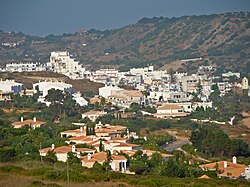Praia da Luz
| Luz | ||
|---|---|---|
| Parish | ||
 |
||
|
||
| Coordinates: 37°06′04″N 8°44′20″W / 37.101°N 8.739°WCoordinates: 37°06′04″N 8°44′20″W / 37.101°N 8.739°W | ||
| Country | Portugal | |
| Region | Algarve | |
| Subregion | Algarve | |
| Intermunic. comm. | Algarve | |
| District | Faro | |
| Municipality | Lagos | |
| Area | ||
| • Total | 21.78 km2 (8.41 sq mi) | |
| Population (2011) | ||
| • Total | 3,545 | |
| • Density | 160/km2 (420/sq mi) | |
| Postal code | 8600 | |
| Area code | 282 | |
| Patron | Nossa Senhora da Luz | |
| Website | http://www.freguesia-luz.pt/portal/v1.0/ | |
Praia da Luz (Portuguese pronunciation: [ˈpɾajɐdɐˈluʃ], changing to [ˈpɾajɐdɐˈluz] before a following vowel), officially Luz, is a civil parish located about 6 kilometres (3.7 mi) from the municipality of Lagos in the Algarve, Portugal. The population in 2011 was 3,545, in an area of 21.78 km². Also known as Luz de Lagos or Vila da Luz (a contraction of its former official name, Vila da Nossa Senhora da Luz), "Praia da Luz" (which means Beach of the Light) is used to refer to both the urbanized village and the beach. The parish had its origins in a small fishing village (the industry is now only found in isolated enclaves to the west), but was transformed by several holiday-villa complexes into a tourist area.
Historians Estácio da Veiga and José da Encarnação have proved that settlements of Luz have existed for millennia, and that many cultures have crossed the territory. At the end of the 19th century, various castros were discovered in the area of Serro Grande, that included various funerary tombs with galleries, dating to the Neolithic period. In these sites there were vestiges of Neolithic implements, artifacts from the Iron Age, as well as a rock axe that was discovered in Espiche. The existence of human artifacts and shell mounds in the area is a constant, suggesting a human presence before organized civilization.
The Romans left behind the remnants of a spa, which represents one of the more important archaeological discoveries of the modern municipality. Following the decline of the Pax Romana, the Algarve began to be threatened by peoples from the lands of ancient Morocco. The Arabs brought with them many of the fruit orchards that continue to exist in the foothills of Luz. Moorish rule in the Algarve resulted in the assimilation of the indigenous cultures, transforming the region into a major economic power.
The Christian conquest and Reconquista resulted in the expulsion of the Moors from the Algarve, in the institutionalization of Christianity and the building of churches. During the Middle Ages, the parish was officially referred to as Nossa Senhora da Luz.
...
Wikipedia


